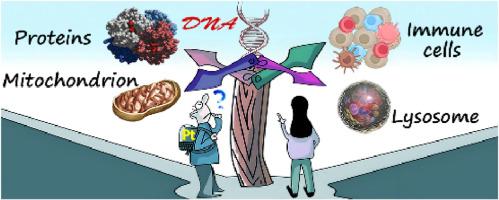当前位置:
X-MOL 学术
›
Eur. J. Med. Chem.
›
论文详情
Our official English website, www.x-mol.net, welcomes your
feedback! (Note: you will need to create a separate account there.)
DNA or Not DNA —That is the Question Determining the Design of Platinum Anticancer Drugs
European Journal of Medicinal Chemistry ( IF 6.0 ) Pub Date : 2024-11-17 , DOI: 10.1016/j.ejmech.2024.117077 Suxing Jin, Chenyao Feng, Xiaoyong Wang
European Journal of Medicinal Chemistry ( IF 6.0 ) Pub Date : 2024-11-17 , DOI: 10.1016/j.ejmech.2024.117077 Suxing Jin, Chenyao Feng, Xiaoyong Wang

|
Platinum drugs are the most widely used chemotherapeutics to treat various tumors. Their primary mode of action is supposed to be inducing apoptosis of cancer cells via covalent binding to DNA. This mechanism has shackled the design of new platinum drugs for many years. Mounting evidence shows that many platinum complexes form non-covalent adducts with DNA or interact with proteins to exhibit significant antitumor activity, thus implying some distinct mechanisms from that of traditional platinum drugs. These unconventional examples indicate that covalent DNA binding is not the precondition for the antitumor activity of platinum complexes, and diversified reactions or interactions with biomolecules, organelles, signal pathways, or immune system could lead to the antitumor activity of platinum complexes. The atypical mechanisms break the classical DNA-only paradigm and structure−activity relationships, thus opening a wide avenue for the design of innovative platinum anticancer drugs.
中文翻译:

DNA 与否 DNA — 这是决定铂类抗癌药物设计的问题
铂类药物是治疗各种肿瘤使用最广泛的化疗药物。它们的主要作用方式应该是通过与 DNA 共价结合诱导癌细胞凋亡。多年来,这种机制一直束缚着新的铂类药物的设计。越来越多的证据表明,许多铂配合物与 DNA 形成非共价加合物或与蛋白质相互作用以表现出显着的抗肿瘤活性,从而暗示了与传统铂类药物不同的机制。这些非常规的例子表明,共价 DNA 结合并不是铂复合物抗肿瘤活性的前提,与生物分子、细胞器、信号通路或免疫系统的多样化反应或相互作用可能导致铂复合物的抗肿瘤活性。非典型机制打破了经典的仅 DNA 范式和结构-活性关系,从而为创新铂类抗癌药物的设计开辟了广阔的道路。
更新日期:2024-11-18
中文翻译:

DNA 与否 DNA — 这是决定铂类抗癌药物设计的问题
铂类药物是治疗各种肿瘤使用最广泛的化疗药物。它们的主要作用方式应该是通过与 DNA 共价结合诱导癌细胞凋亡。多年来,这种机制一直束缚着新的铂类药物的设计。越来越多的证据表明,许多铂配合物与 DNA 形成非共价加合物或与蛋白质相互作用以表现出显着的抗肿瘤活性,从而暗示了与传统铂类药物不同的机制。这些非常规的例子表明,共价 DNA 结合并不是铂复合物抗肿瘤活性的前提,与生物分子、细胞器、信号通路或免疫系统的多样化反应或相互作用可能导致铂复合物的抗肿瘤活性。非典型机制打破了经典的仅 DNA 范式和结构-活性关系,从而为创新铂类抗癌药物的设计开辟了广阔的道路。


















































 京公网安备 11010802027423号
京公网安备 11010802027423号